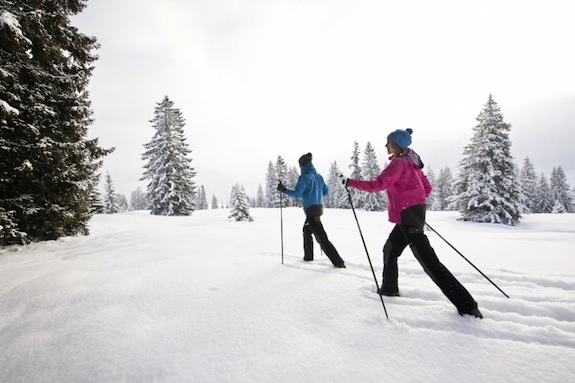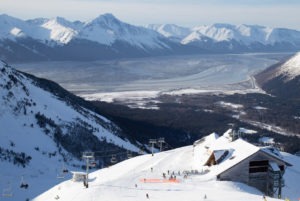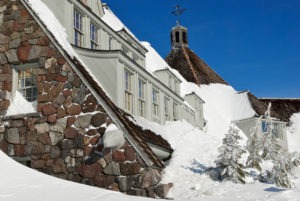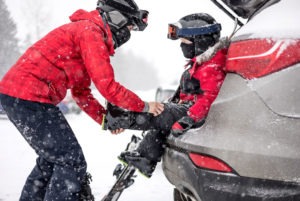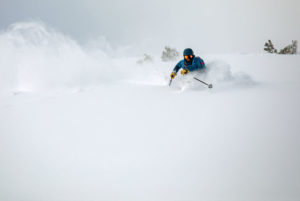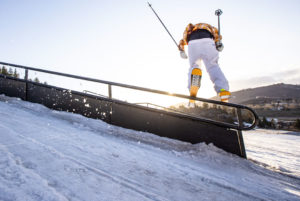
There’s more to being a cross-country skiier than having the right gear or wearing the right pants. To be a true player in a sport, you need to be familiar with the terminology! Sure, you’ll learn it over time as you meet fellow cross country skiers, but why not brush up with our list of the most common terms below? It’s also a good idea to familiar yourself with common terms before embarking on a new purchase. Here goes…
Alpine Skiing – Downhill skiing or the most common type of skiing with lifts. Gear includes hard plastic boots, fixed heel bindings and skis with either a rocker or camber shape.
Alpine Touring (AT) – Backcountry skiing, commonly known as randonee or ski mountaineering, with free-heel strides and climbing skins for ascending a mountain that switch to fixed heel bindings for descending. Descending the slope typically happens in a more horizontal fashion due to extremely steep terrain.
Backcountry Skiing – Skiing on undeveloped land, without ski lifts or open roads. Cross-country skiing, telemark skiing or randonee can all be enjoyed in backcountry terrain.
Base – The bottom of a ski typically made of different materials depending on the type of ski.
Basket – The plastic disk at the end of a ski pole, used to push off in cross- country skiing.
Biathlon – Olympic and World Cup cross-country skiing event, where skiers ski a certain distance while carry rifles, then test their precision while shooting at targets.
Camber – Upward curve in the in the middle of the length of the ski. An Alpine (single) camber is the curvature of the ski to evenly distribute the weight of the skier. A Nordic (double) camber provides traction by lifting the ski base off the snow.
Classic Technique – The most common cross country skiing technique of opposite arm and leg forward movement, also known as a kick and glide. The diagonal stride is another term for classic technique.
Cross Country – Also known as Nordic Skiing or XC, encompassing general touring, metal-edge skiing and skate skiing.
Cross Country Ski Center – A commercial area for cross country skiers with groomed trails, also offering lessons, rentals, food, first-aid, warming shelters and sometimes lit trails.
Diagonal Stride – The cross-country skiing forward movement, with body weight moved to the front leg and slide forward, while the back leg extends behind with the ski slightly lifted. (See classic technique)
Extruded Ski Base – An extruded base is found on general touring skis, made from polyethylene pellets.
FIS – Federation of International Skiing
Flex – This refers to the stiffness of a ski and the amount to which it resists bending. Soft-Flex skis bend more easily and are best for softer snow at slower speeds. Stiff-Flex skis don’tbend quite so easily, and are better on harder snows and with faster speeds.
Glide Wax – The wax used on skis to improve the glide and to protect the base from wear and oxidation. Touring skis are waxed on the tip and tail, while it is applied to the entire base of skate and telemark skis.
Glide Zone – The part of the ski (tip and tail) waxed to improve the glide.
Grip (kick) Wax – Wax used to provide traction for skis. This traction occurs when the rough edges of the snow crystals penetrate the wax layer just enough to grab hold of the ski when it is stationary and weighted.
Groomed Trail – A ski trail that has been smoothed down by a machine for easier skiing, especially on ski resorts.
Header, Face Plant, Melon Slide, Nose Burner – Falling face-first into the snow
Holmenkollen – Norwegian ski slope, home of the cross-country World Cup.
Klister – A sticky gel used for grip wax in old and wet snow.
New Nordic Norm (NNN) – A boot/binding system designed specifically to help with flex and control.
Nordic Combined – An Olympic and World Cup event involving jumping and cross-country skiing.
Nordic Integrated System (NIS) – A variation of the NNN with a different boot/binding connection.
Nordic Norm/3-Pin – The traditional, three pin binding between boots and skis.
Off Piste – Skiing out of bounds.
Off-Track Skiing – Skiing outside of prepared skiing zones.
Pin Head/Pinner – A telemark skier, referring specifically to the 3-pin binding.
Pole Grip – The handle of the ski pole.
Rollerskis – Off-snow training for cross country skiers, with short skis with wheels on both ends to be used on pavement or off road. Skate skiers train in the summer on rollerskis.
Salomon Nordic Skis (SNS) – A Salomon boot/binding with a single, wide binding, not compatible with NNN systems.
Sidecut – The arches on the sides of skis that help with the turning of skis. Skis typically turn easier with more sidecut.
Sintered Ski Base – A base made of heated (but not melted) polyethylene used on higher end ski models. IT creates a base with microscopic one spaces between the polyethylene molecules into which wax can penetrate and reside. because of the expense. The result is a fast base that requires more frequent application of glide wax.
Sitzmark -The indentation in the snow made by a fallen skier. It is proper etiquette to repair your Sitzmark should you fall on a groomed cross country trial.
Skate Skiing – A cross-country skiing technique where the tips of skis kept apart and the skier pushes forward like an ice skater.
Skijoring – Cross country skiing while being pulled by a dog (or sometimes a horse or reindeer).
Ski Orienteering – An endurance cross country discipline combining navigation and cross-country skiing across a rough terrain using prepared cross-country ski tracks. A topographical map and compass are used to locate a series of control points. A ski orienteer combines top notch endurance and strength, excellent technical skiing skills and the ability to choose the best routes.
Skins – Pieces of synthetic material placed on the bottom of skis to provide traction used for going uphill.
Stick Wax – Color coded wax for various temperatures, stick wax is applied directly to skis like crayons.
Telemark – A skiing technique with one ski forward and the other leg bent behind to provide better stability for downhill skiing. Telemark skis can be used at resorts with lifts or in the backcountry.
Track Skiing – Crossing-country skiing on groomed snow with the classic or skating technique.
USSA – United States Skiing Association
Wax – Wax (kick or glide) is applied to skis to help with traction or glide.
Wax Pocket – The center section on Nordic camber skis that is lifted slightly off the snow. When the skiers’ weight is on the skis, the center of the camber curve touches the snow and grips it.
Waxless Skis – Classic skis and bindings that grip the snow without the aid of wax on the middle third of the skis. The kick zones instead have fish, cross-hatched or ridged pattern cut into the base material to provide grip. Waxless skis preform best with periodic glide waxing on the tips and tails to improve gliding performance and to keep the P-tex base material from drying out.
Width – The distance between the two edges of skis, measured at the narrowest part of the ski.
World Cup – The most important cross-country competition outside of the Olympics and World Championships consisting of multiple international ski races in Europe every season.
